Apulia
Puglia[lower-alpha 1] | |
|---|---|
 Coat of arms | |
 | |
| Coordinates: 41°N 16°E / 41°N 16°E | |
| Country | Italy |
| Capital | Bari |
| Government | |
| • Body | Regional Council |
| • President | Michele Emiliano (PD) |
| Area | |
| • Total | 19,358 km2 (7,474 sq mi) |
| Population (31 December 2016) | |
| • Total | 4,063,888 |
| • Density | 210/km2 (540/sq mi) |
| Demonym(s) | English: Apulian Italian: Pugliese |
| GDP | |
| • Total | €77.984 billion (2021) |
| Time zone | UTC+01:00 (CET) |
| • Summer (DST) | UTC+02:00 (CEST) |
| ISO 3166 code | IT-75 |
| HDI (2021) | 0.856[2] very high · 18th of 21 |
| NUTS Region | ITF |
| Website | regione.puglia.it |
Apulia (/əˈpuːliə/ ə-POO-lee-ə), also known by its Italian name Puglia (pronounced [ˈpuʎʎa]),[3][lower-alpha 1] is a region of Italy, located in the southern peninsular section of the country, bordering the Adriatic Sea to the east, the Strait of Otranto and Ionian Sea to the southeast and the Gulf of Taranto to the south. The region comprises 19,345 square kilometers (7,469 sq mi), and its population is about four million people. It is bordered by the other Italian regions of Molise to the north, Campania to the west, and Basilicata to the southwest. Its chief town is Bari.
In ancient times, part of its territory belonged to Magna Graecia being populated by coastal Greek colonies. Later, the region was conquered by the ancient Romans. It was then conquered by the Byzantines, followed by the Normans, the Aragonese and the Spanish. Subsequently, it became part of the Kingdom of the Two Sicilies, to then be annexed to the unified Kingdom of Italy after the Expedition of the Thousand.
Geography
Apulia's coastline is longer than that of any other mainland Italian region. In the north, the Gargano promontory extends out into the Adriatic sea like a "sperone" ("spur"), while in the south, the Salento peninsula forms the "tacco" ("heel") of Italy's boot.[4] The highest peak in the region is Monte Cornacchia 1,152 m (3,780 ft) above sea level) within the Daunian Mountains, in the north along the Apennines.
It is home to two national parks, the Alta Murgia National Park and Gargano National Park.[5]
Outside national parks in the North and West, most of Apulia particularly the Salento peninsula is geographically flat with only moderate hills.
The climate is typically Mediterranean with hot, dry and sunny summers and mild and rainy winters. Snowfall, especially on the coast is rare but has occurred as recently as January 2019 (following on from snow in March 2018 and January 2017). Apulia is among the hottest and driest regions of Italy in summer, with temperatures sometimes reaching and exceeding 40 °C (104 °F) in Lecce and Foggia.
The coastal areas, particularly on the Adriatic Sea and in the southern Salento peninsula, are frequently exposed to winds of varying strengths and directions, strongly affecting local temperatures and conditions, sometimes within the same day. The Northerly Bora wind from the Adriatic Sea can lower temperatures, humidity and moderate summer heat while the Southerly Sirocco wind from North Africa can raise temperatures, and humidity and occasionally drop red dust from the Sahara Desert. On some days in spring and autumn/fall, it can be warm enough to swim in Gallipoli and Porto Cesareo on the Ionian coast while at the same time, cool winds warrant jackets and jumpers/sweaters in Monopoli and Otranto on the Adriatic coast.
The area between Otranto and Santa Maria di Leuca is part of the Regional Natural Coastal Park of "Costa Otranto — Santa Maria di Leuca e Bosco di Tricase" wanted by the Apulia Region in 2008. This territory has numerous natural and historical attractions such as Ciolo, which is a rocky cove.

History


Apulia is one of the richest archaeological regions in Italy. It was first colonised by Mycenaean Greeks.[6] The region became one of the centres of Magna Graecia, with the foundation along its coasts of many Greek city-states (póleis).
The origin of the toponym Apulia (Latin Āpūlia, whence its modern Italian name Puglia derives) is unknown. The Greeks referred to the region as Ἰαπυγία (Iāpygíā) owing to the presence of the three main Iapygian tribes that inhabited Apulia during the first millennium B.C.: the Daunians in the North, the Peucetians in the Centre, and the Messapians in the South.[7][8]
Some parts of the regions were conquered by the Muslim Saracens and the Emirate of Bari was established for a brief period by Muhammad Abul Abbas of Sicily.
Several castles were built in the area by the King of Sicily and Holy Roman Emperor Frederick II, including Castel del Monte,[9] sometimes called the Crown of Apulia.[10]
Apulia was an autonomous duchy until 1130 when its duke became king of Sicily. After 1282, when the kingdom lost the island of Sicily itself, Apulia remained part of the remnant Kingdom of Naples (confusingly known also as the Kingdom of Sicily) and remained so until the unification of Italy in 1861. This kingdom was independent under the House of Anjou from 1282 to 1442, then was part of the Crown of Aragon until 1458, after which it was again independent under a cadet branch of the House of Trastámara until 1501. As a result of the French–Spanish war of 1501–1504, Naples again came under the rule of the Crown of Aragon and the Spanish Empire from 1504 to 1714. When Barbary pirates of North Africa sacked Vieste in 1554, they took an estimated 7,000 slaves.[11] The coast of Apulia was occupied at times by the Ottoman Turks and at other times by the Venetians.[12]
In 1861 the region became part of the Kingdom of Italy.[13]
Economy
The region's contribution to Italy's gross value added was around 4.6% in 2000, while its population was 7% of the total. The per capita GDP is low compared to the national average and represents about 68.1% of the EU average.[14]
The share of gross value added by the agricultural and services sectors was above the national average in 2000. The region has industries specialising in particular areas, including food processing and vehicles in Foggia; footwear and textiles in the Barletta province, and wood and furniture in the Murge area to the west.[15]
Between 2007 and 2013 the economy of Apulia expanded more than that of the rest of southern Italy.[16] Such growth, over several decades, is a severe challenge to the hydrogeological system.[17]
Apulia's thriving economy is articulated into numerous sectors boasting several leading companies, but most of them produce materials or components, not finished goods:
- Aerospace (Leonardo, Avio Aero, Sitael, Blackshape)
- Automotive (Bosch,[18] Magneti Marelli, Magna Gertrag, Bridgestone)
- Mechanics (New Holland Construction, IVECO Motori, Isotta Fraschini Motori, MERMEC)
- Furniture (Natuzzi)
- Food and Beverage (De Carlo, Divella, Quarta Caffé)
- Agriculture (Casillo Group, G.C. Partecipazioni)
- Publishing (Laterza, Edizioni Dedalo)
- Tourism (Nicolaus tour)
- Logistics (GTS Rail)
- I.C.T. (Exprivia)
In Taranto, there is the largest metallurgical work ILVA Acciaierie di Taranto (8,200 empl.) in Europe with a full iron and steel production cycle. It will be sold to Arcelor Mittal.[19]
In Brindisi, there is a chemical industrial park with an ENI power station, ENI oil refinery, Syndial chemical factory, and Versalis chemical factory (basic chemistry, intermediates, polyethene, styrenics and elastomers). LyondellBasell polypropylene plant, Sanofi plant (antibiotics). Another ENI oil refinery is located in Taranto.[20]
Unemployment
The unemployment rate stood at 14.1% in 2020.[21]
| Year | 2006 | 2007 | 2008 | 2009 | 2010 | 2011 | 2012 | 2013 | 2014 | 2015 | 2016 | 2017 | 2018 | 2019 | 2020 |
|---|---|---|---|---|---|---|---|---|---|---|---|---|---|---|---|
| unemployment rate (in %) |
12.6% | 11.1% | 11.6% | 12.6% | 13.5% | 13.2% | 15.7% | 19.7% | 21.5% | 19.7% | 19.4% | 18.8% | 16.1% | 14.9% | 14.1% |
Fishing and aquaculture
The port of Taranto hosts numerous fishing boats. The fleet is mainly made up of about 80 fishing boats, which do not exceed 10 gross tonnage and which practice trawling, while the remaining small-scale fishing boats operate with gillnets. The sea, rich and generous, is populated by dentex and sea bream, grouper, mullet and anchovies, shrimp and squid. Other significant fishing ports are Manfredonia, Molfetta, Mola di Bari, Monopoli, Gallipoli and Castro.
Today Taranto is the world's largest producer of farmed mussels: with 1,300 employees, around 30,000 tons of mussels are processed per year. Mussel farming has characterized the city's economy for centuries, making the mussel the gastronomic symbol of Taranto. It is said that the first mussel gardens in La Spezia, Pula, Olbia and Chioggia were established by mussel farmers who emigrated from this city. The workplace of the Taranto mussel farmers is the boat; every detail of the working method has improved over time.
10 m long structures made of wood or metal, called "pali" (piles), are attached to the seabed, to which ropes and nets are then attached, on which the mussels are grown. The mussels farmed here are particularly tasty and valued because they grow in a special environment, a mixture of salt seawater and karst freshwater. These special environmental conditions of the seas of Taranto are ideal not only for the mussels but also for the fish and crustaceans that find food and shelter between the piles. While there are around 18 submarine freshwater springs, called "Citri", in the Mar Piccolo, there is only one large one in the Mar Grande, which is called "Anello di San Cataldo" in honour of the patron saint of the city.
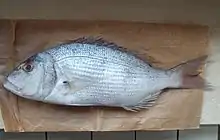 Dentex
Dentex Sea bream
Sea bream Shrimp
Shrimp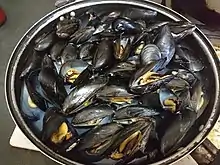 Mussels
Mussels
Agriculture
Agriculture plays a prominent economic role in Apulia. It is mainly intensive and modern agriculture that allows the region to be among the first in Italy for the production of many products:
Vegetable growing (lettuce, artichoke, fennel, cabbage, celery, barattiere, borage, sweet potato, caper, portulaca) and horticulture (kiwis, peaches, orange, clementine, lemon) are also developed.
Viticulture

Vineyards cover 106.715 ha (263.70 acres) in Apulia, which is 1st place among Italian grape-growing regions. But in the production of quality DOC and DOCG wines, Apulia has only ranked 12th of 20 with 297.667 hl. There are four DOCG wines:
- Castel del Monte Bombino Nero
- Castel del Monte Nero di Troia Riserva
- Castel del Monte Rosso Riserva
- Primitivo di Manduria Dolce Naturale
Oliviculture


There are an estimated 50 to 60 million olive trees in Apulia, and the region accounts for 40% of Italy's olive oil production. There are four specific Protected designations of Origin (PDO) covering the whole region.[22] Olive varieties include: Baresane, Biancolilla, Brandofino (Castiglione), Buscionetto (Biancolilla), Carolea, Cellina di Nardò, Cerasuola (Ogliara), Cerignola (Bella di Cerignola), Cima di Bitonto, Cima di Mola, Coratina,[23] also grown in Corning, California, a 2018 Gold Medal New York International Olive Oil Competition (NYIOOC) winner,[24] Frantoio, Garganica, La Minuta, Leccino, Moresca, Nocellara Etnea, Nocellara Messinese, Ogliarola, Ogliarola Barese, Ogliara Messinese, Ottobratica, Peranzana, Rotondella, Santagatese, Saracena, Tonda Iblea, and Verdello (subspecies of San Benedetto).[25][26]
Xylella fastidiosa disease
Since 2008–2010, the olive oil industry in Apulia has been under threat from the pathogen Xylella fastidiosa, a disease that inhibits the trees' uptake of water and nutrients. The epicentre of the epidemic is the southeastern part of the region.
Transport
The region has a good network of roads, but the railway network is less comprehensive, particularly in the south. There are no high-speed lines, but a high-speed line between Naples and Bari is under construction, which should be completed in 2027.[27] The region is crossed northwest to southeast by the A14 highway (Bologna–Taranto), which connects the region's capital, Bari, to Taranto, the second most populous city in the region. The A14 also connects Foggia and points further north along the Adriatic coast to Pescara, Ancona, Rimini and eventually Bologna. The only other highway in the region is the A16 (Naples–Canosa), which crosses the Italian peninsula east–west and links the region with Naples.
There are two international airports, Karol Wojtyla Airport in Bari (IATA: BRI) and Brindisi Airport (IATA: BDS), which serve as the principal logistical hub for the United Nations Global Service Center headquartered in Brindisi. With the approval of a redevelopment project in 2018, the Grottaglie Airfield (IATA: TAR) will host a spaceport for the Italian Space Agency and Virgin Galactic.
Demographics
| Year | Pop. | ±% |
|---|---|---|
| 1861 | 1,335,000 | — |
| 1871 | 1,440,000 | +7.9% |
| 1881 | 1,609,000 | +11.7% |
| 1901 | 1,987,000 | +23.5% |
| 1911 | 2,195,000 | +10.5% |
| 1921 | 2,365,000 | +7.7% |
| 1931 | 2,508,000 | +6.0% |
| 1936 | 2,642,000 | +5.3% |
| 1951 | 3,220,000 | +21.9% |
| 1961 | 3,421,000 | +6.2% |
| 1971 | 3,583,000 | +4.7% |
| 1981 | 3,872,000 | +8.1% |
| 1991 | 4,032,000 | +4.1% |
| 2001 | 4,021,000 | −0.3% |
| 2011 | 4,091,000 | +1.7% |
| 2017 | 4,063,888 | −0.7% |
| Source: ISTAT 2001 | ||
Emigration from the region's depressed areas to northern Italy and the rest of Europe was very intense in the years between 1956 and 1971. Subsequently, the trend declined, as economic conditions improved, to the point where there was net immigration in the years between 1982 and 1985. Since 1986, the stagnation in employment has led to a new inversion of the trend caused by a decrease in immigration.[28]
Government and politics
Since 1 June 2015, former judge and mayor of Bari Michele Emiliano of the Democratic Party has served as President of the Apulian region.[29][30]
Administrative divisions

Apulia is divided into six provinces:
| Province | Population |
|---|---|
| Metropolitan City of Bari | 1,261,954 |
| Province of Lecce | 802,807 |
| Province of Foggia | 627,102 |
| Province of Taranto | 581,092 |
| Province of Brindisi | 401,652 |
| Province of Barletta-Andria-Trani | 384,293 |
Culture
Cuisine
Important locally produced ingredients include olive oil, artichokes, tomatoes, eggplant, asparagus, and various kinds of seafood. Local specialties include the carosello, a variety of muskmelon which is often consumed when unripe. Apulian Protected designation of origin (PDO) and Protected Geographical indication (PGI) products included cheeses, olive oils, fruits and vegetables, and a type of bread.
Typically Apulian pasta shapes are orecchiette, cavatelli, and troccoli. Popular street foods include panzerotti, sgagliozze (fried polenta), popizze (small fried balls of pizza dough that are sometimes also called pettule), rustici (puff pastries stuffed with tomatoes, béchamel sauce, mozzarella, and black pepper), the famous pasticiotto (a flaky shortbread dough filled with custard), and focaccia barese.[31] A popular snack in Apulia is Taralli.
 Spaghetti con le cozze (with mussels)
Spaghetti con le cozze (with mussels)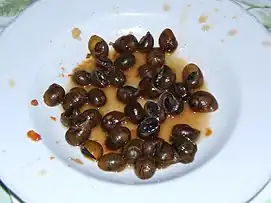 Monacelle (land snail species Cantareus apertus)
Monacelle (land snail species Cantareus apertus) Scapece gallipolina: fried fish preserved in red wine vinegar with bread crumbs and saffron
Scapece gallipolina: fried fish preserved in red wine vinegar with bread crumbs and saffron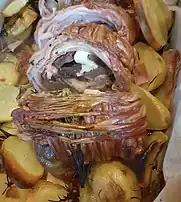 Cazzomarro: baked involtini of lamb entrails
Cazzomarro: baked involtini of lamb entrails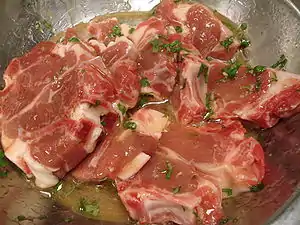 Goat chops
Goat chops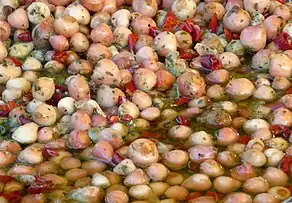 Lampascioni sott'olio, prepared bulbs of the grape hyacinth Leopoldia comosa preserved in olive oil
Lampascioni sott'olio, prepared bulbs of the grape hyacinth Leopoldia comosa preserved in olive oil
Language
As with the other regions of Italy, the national language (since 1861) is Italian. However, because of its long and varied history, other historical languages have been used in this region for centuries. The local languages of northern and central Apulia (roughly the provinces of Bari, Barletta-Andria-Trani, and Foggia as well as the northwestern parts of the Province of Taranto) are the Apulian Southern Italo-Romance dialects, including Bari dialect and Tarantino dialect. In the southern region of Salento, an extreme Southern Italo-Romance language, the Salentino dialect is widely spoken. There is also an Italiot Greek language found in Salento called Griko, which is still spoken by a few thousand Griko people in some areas.[32] In addition, a rare daughter language of the Franco-Provençal language called Faetar is spoken in the mountain villages of Faeto and Celle di San Vito, in the Province of Foggia. It is sometimes classified as a pair of dialects of Franco-Provençal, Faetar and Cellese.[33] The Arbëreshë dialect of the Albanian language has been spoken by a small community since refugees settled there in the 16th century.[34]
Sports
Apulia is home to several national football, water polo, volleyball, basketball and tennis clubs.
Across the top three levels of Italian football, the clubs in Apulia include:
- U.S. Lecce playing in Serie A
- S.S.C. Bari playing in Serie B
- Calcio Foggia 1920 playing in Serie C
- S.S. Audace Cerignola playing in Serie C
- Fidelis Andria 2018 playing in Serie C
- S.S. Monopoli 1966 playing in Serie C
- Virtus Francavilla Calcio playing in Serie C
- Taranto F.C. 1927 playing in Serie C
See also
Explanatory notes
References
- ↑ "Population on 1 January by age, sex and NUTS 2 region", www.ec.europa.eu
- ↑ "Sub-national HDI - Area Database - Global Data Lab". hdi.globaldatalab.org. Archived from the original on 23 September 2018. Retrieved 5 March 2023.
- ↑ "Puglia travel". Lonely Planet. Retrieved 18 July 2021.
- ↑ "Introducing Puglia". Lonely Planet. Archived from the original on 1 July 2017. Retrieved 8 July 2017.
- ↑ "Holiday guide to Puglia, southern Italy: the best towns, restaurants and hotels". The Guardian. 4 July 2015. Archived from the original on 16 November 2016. Retrieved 15 November 2016.
- ↑ Fisher, Elizabeth A. (1998). The Mycenaeans and Apulia. An Examination of Aegean Bronze Age Contacts with Apulia in Eastern Magna Grecia. Astrom.
- ↑ Lombardo, M. (2014). T. Carpenter, K. Lynch, E. Robinson (ed.). "Iapygians: The Indigenous Populations of Ancient Apulia in the Fifth and Fourth Centuries B.C.E.". The Italic People of Ancient Apulia: New Evidence from Pottery for Workshops, Markets, and Customs. Cambridge: Cambridge University Press: 36–68. doi:10.1017/CBO9781107323513.005.
{{cite journal}}: CS1 maint: multiple names: editors list (link) - ↑ Carpenter, T.; Lynch, K.; Robinson, E., eds. (2014). The Italic People of Ancient Apulia: New Evidence from Pottery for Workshops, Markets, and Customs. Cambridge: Cambridge University Press. doi:10.1017/CBO9781107323513.
- ↑ "Italy: Puglia". RoughGuides.com. Archived from the original on 12 December 2013. Retrieved 8 December 2013.
- ↑ Götze, Heinz (1998). Castel Del Monte: Geometric Marvel of the Middle Ages. p. 89.
- ↑ Asaolu, Richard Oluseyi (n.d.). Slavery: Abolition. Mainz: Pedia. p. 50. Retrieved 3 June 2017.
- ↑ Dursteler, Eric R., ed. (2013). A Companion to Venetian History, 1400-1797. Leiden: Koninklejke. pp. 142–43. ISBN 978-9004252516. Retrieved 3 June 2017.
- ↑ Gilmour, David (2012). The Pursuit of Italy: A History of a Land, Its Regions and their Peoples. p. 24.
- ↑ "Eurostat". Greenreport. Archived from the original on 24 April 2014. Retrieved 2 August 2010.
- ↑ "Puglia - Economy". Portrait of the Regions. Eurostat. March 2004. Archived from the original on 21 August 2009. Retrieved 8 July 2017.
- ↑ Massimo Monteduro, Pierangelo Buongiorno, Saverio Di Benedetto, Law and Agroecology: A Transdisciplinary Dialogue (2015), p. 176
- ↑ Amílcar Soares, Maria João Pereira, Roussos Dimitrakopoulos! geoENV VI – Geostatistics for Environmental Application (2008), p. 191: "The approach highlighted the widespread degradation of water resources in the Apulian groundwater. ... Above all the rapid socio-economic growth over the last decades has caused severe stress to the Apulian hydrogeological system."
- ↑ "Bosch in Italia" (in Italian).
- ↑ "Taranto Steelworks" (in Italian). 5 November 2019.
- ↑ "Brindisi Industriale" (in Italian). Archived from the original on 13 May 2021. Retrieved 13 May 2021.
- ↑ "Unemployment NUTS 2 regions Eurostat".
- ↑ PDO status Archived 6 July 2018 at the Wayback Machine- Retrieved 6 July 2018
- ↑ Coratina olive Archived 6 July 2018 at the Wayback Machine- Retrieved 5 July 2019
- ↑ Coratina olives in Ca. Archived 6 July 2018 at the Wayback Machine- Retrieved 5 July 2018
- ↑ Apulia region cultivars Archived 6 July 2018 at the Wayback Machine- Retrieved 20180-7-05
- ↑ Puglia olive cultivars Archived 6 July 2018 at the Wayback Machine- Retrieved 5 July 2018
- ↑ "Naples - Bari" (in Italian). Ferrovie Dello Stato Italiane. Retrieved 15 August 2023.
- ↑ "Eurostat". c.europa.eu. Archived from the original on 21 July 2011. Retrieved 22 April 2010.
- ↑ "Scheda Personale". Sito web Istituzionale della Regione Puglia (in Italian). Archived from the original on 5 September 2015. Retrieved 17 October 2015.
- ↑ "BIOGRAFIA" (PDF). CompletaMente.org (in Italian). Archived from the original (PDF) on 4 March 2016. Retrieved 5 September 2015.
- ↑ "A Local's Guide to The Best Food in Puglia". Go Ask A Local. 18 August 2022.
- ↑ "Ethnologue report for language code:ell". Ethnologue.com. Archived from the original on 28 May 2010. Retrieved 22 April 2010.
- ↑ Nagy, Naomi (2011). "A Multilingual Corpus to Explore Variation in Language Contact Situations" (PDF). Rassegna Italiana di Linguistica Applicata. 43 (1–2): 3. Archived from the original (PDF) on 4 February 2017. Retrieved 3 February 2017.
- ↑ "Ethnologue report for language code:aae". Ethnologue.com. Archived from the original on 2 October 2012. Retrieved 13 July 2016.
Further reading
- Desmond Seward, An Armchair Traveller's History of Apulia (Haus Publishing, 2013)
- Stefania Mola, Apulia: the Cathedrals (Adda, 2008)
- Francesco Carofiglio, Apulia, a Tourist's Guide to the Culture of Apulia (1988)
- Susanna Gelmetti, Italian Country Cooking: Recipes from Umbria & Apulia (1996), ISBN 1872803229
- Apulia: A Film Tourism Guide (Laterza, 2009, 246 pp)
- Tessa Garton, Early Romanesque Sculpture in Apulia (Courtauld Institute, 1984)
- Ashby, Thomas (1911). . In Chisholm, Hugh (ed.). Encyclopædia Britannica. Vol. 2 (11th ed.). Cambridge University Press. pp. 235–236.
- Roy Domenico (2002). "Apulia". Regions of Italy: a Reference Guide to History and Culture. Greenwood. ISBN 0313307334.
External links
- Official website (in Italian)
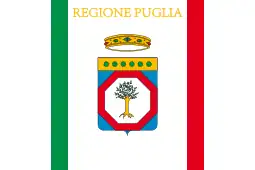

.jpg.webp)